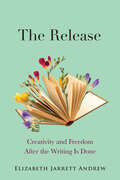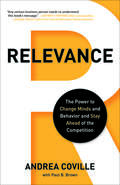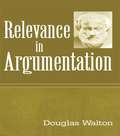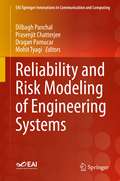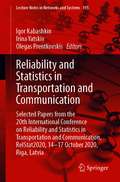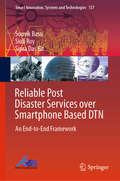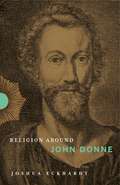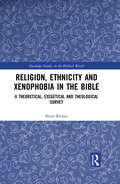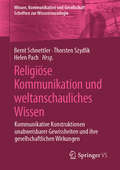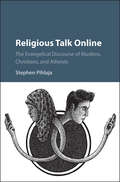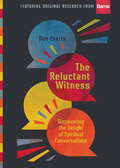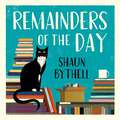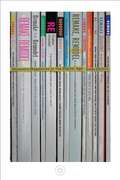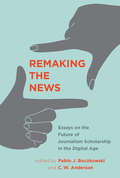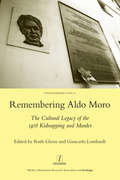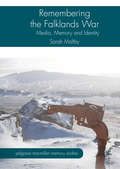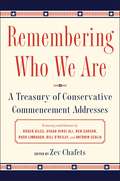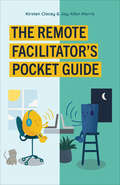- Table View
- List View
The Release: Creativity and Freedom After the Writing Is Done
by Elizabeth Jarrett AndrewThe release is the stage when writers share the soul of their project—its gift. Here’s how to thrive and best serve your work once the writing is done.In The Release, award-winning author and teacher Elizabeth Jarrett Andrew invites writers to lift their heads out of the product-oriented sandbox and find an alternative way to play. By returning writers to their original delight and guiding them in an ongoing creative practice, Andrew helps form habits of mind, heart, and body to support a project’s final flourishing, free from the burdens of seeking validation and measuring worth.With the same skill and compassion she brought to her other resources for writers—Writing the Sacred Journey: The Art and Practice of Spiritual Memoir and Living Revision: A Writer's Craft as Spiritual Practice—Andrew writes with deep empathy for the emotional journey when a work is done, through celebration and grief, decisions around publication, the angst of receiving negative feedback or rejection, and the sometimes surprising challenges that come with success.Anyone—amateurs and professionals alike, those who intend to publish and those who do not, those with book-length manuscripts and those with haiku written on paper scraps—can do this practice. This book is for anyone who wants to release their work with love.
Relevance: The Power to Change Minds and Behavior and Stay Ahead of the Competition
by Andrea CovilleToday, when companies and customers are faced with an infinite number of messages, the word "relevance" has taken on a new meaning and dimension. We know that relevance matters, but what does that mean exactly? Andy Coville guides leaders and executives toward the realization that if they can focus on a single, guiding principle--a magnetic one--that permeates their brand or company, customers will not only engage but change thinking and behavior in turn. Relevance takes us through the dimensions of relevance--both qualitative and quantitative--in order to find the starting point on the Relevance Scale: where we are and where to go from here. The book walks the reader through the elements of staying relevant as well as the circumstances that contribute to establishing a relevance platform. The author offers many examples as well as explaining messaging strategies. Whether you are working with a consumer product, a nonprofit, or a B2B company, Andy Coville believes you, your brand, or your company have the power to change and influence behavior and make an impact.
Relevance in Argumentation (Pragmatics And Beyond Ser. #Iii:8)
by Douglas WaltonIn Relevance in Argumentation, author Douglas Walton presents a new method for critically evaluating arguments for relevance. This method enables a critic to judge whether a move can be said to be relevant or irrelevant, and is based on case studies of argumentation in which an argument, or part of an argument, has been criticized as irrelevant. Walton's method is based on a new theory of relevance that incorporates techniques of argumentation theory, logic, and artificial intelligence. The work uses a case-study approach with numerous examples of controversial arguments, strategies of attack in argumentation, and fallacies. Walton reviews ordinary cases of irrelevance in argumentation, and uses them as a basis to advance and develop his new theory of irrelevance and relevance. The volume also presents a clear account of the technical problems in the previous attempts to define relevance, including an analysis of formal systems of relevance logic and an explanation of the Grecian notion of conversational relevance. This volume is intended for graduate and advanced undergraduate courses in those fields using argumentation theory--especially philosophy, linguistics, cognitive science and communication studies, in addition to argumentation. The work also has practical use, as it applies theory directly to familiar examples of argumentation in daily and professional life. With a clear and comprehensive method for determining relevance and irrelevance, it can be convincingly applied to highly significant practical problems about relevance, including those in legal and political argumentation.
Reliability and Risk Modeling of Engineering Systems (EAI/Springer Innovations in Communication and Computing)
by Dilbagh Panchal Prasenjit Chatterjee Dragan Pamucar Mohit TyagiThis book addresses reliability, maintenance, risk, and safety issues of industrial systems with applications of the latest decision-making techniques. Thus, this book presents chapters that apply advanced tools, techniques, and computing models for optimizing the performance of industrial and manufacturing systems, along with other complex engineering equipment. Computing techniques like data analytics, failure mode and effects analysis, fuzzy set theory, petri-net, multi-criteria decision-making (MCDM), and soft computing are used for solving problems of reliability, risk, and safety related issues.
Reliability and Statistics in Transportation and Communication: Selected Papers from the 20th International Conference on Reliability and Statistics in Transportation and Communication, RelStat2020, 14-17 October 2020, Riga, Latvia (Lecture Notes in Networks and Systems #195)
by Igor Kabashkin Irina Yatskiv Olegas PrentkovskisThis book reports on cutting-edge theories and methods for analyzing complex systems, such as transportation and communication networks and discusses multi-disciplinary approaches to dependability problems encountered when dealing with complex systems in practice. The book presents the most noteworthy methods and results discussed at the International Conference on Reliability and Statistics in Transportation and Communication (RelStat), which took place remotely from Riga, Latvia, on October 14 – 17, 2020. It spans a broad spectrum of topics, from mathematical models and design methodologies, to software engineering, data security and financial issues, as well as practical problems in technical systems, such as transportation and telecommunications, and in engineering education.
Reliable Post Disaster Services over Smartphone Based DTN: An End-to-End Framework (Smart Innovation, Systems and Technologies #137)
by Souvik Basu Siuli Roy Sipra Das BitThis book proposes a framework and strategies for reliable end-to-end post-disaster services using smartphone-based delay-tolerant networks, which can operate even in the absence of conventional network connectivity. It explores various aspects of this challenge, ranging from accurate need assessment, to timely need accumulation, efficient resource allocation, and reliable data dissemination. The book offers insightful reading for all technologists and researchers working in the domain of ICT-based disaster management in developing countries, and will help them grasp the challenges involved in providing post-disaster services in an extremely difficult network scenario, while also offering possible solutions. The book will also benefit disaster management authorities, government agencies, NGOs and other stakeholders, helping them enhance their preparedness through the intelligent use of wireless technologies coupled with smart devices.
Religion Around John Donne (Religion Around #4)
by Joshua EckhardtIn this volume, Joshua Eckhardt examines the religious texts and books that surrounded the poems, sermons, and inscriptions of the early modern poet and preacher John Donne. Focusing on the material realities legible in manuscripts and Sammelbände, bookshops and private libraries, Eckhardt uncovers the myriad ways in which Donne’s writings were received and presented, first by his contemporaries, and later by subsequent readers of his work.Eckhardt sheds light on the religious writings with which Donne’s work was linked during its circulation, using a bibliographic approach that also informs our understanding of his work’s reception during the early modern period. He analyzes the religious implications of the placement of Donne’s poem “A Litany” in a library full of Roman Catholic and English prayer books, the relationship and physical proximity of Donne’s writings to figures such as Sir Thomas Egerton and Izaak Walton, and the movements in later centuries of Donne’s work from private owners to the major libraries that have made this study possible. Eckhardt’s detailed research reveals how Donne’s writings have circulated throughout history—and how religious readers, communities, and movements affected the distribution and reception of his body of work.Centered on a place in time when distinct methods of reproduction, preservation, and circulation were used to negotiate a complex and sometimes dangerous world of confessional division, Religion Around John Donne makes an original contribution to Donne studies, religious history, book history, and reception studies.
Religion, Ethnicity and Xenophobia in the Bible: A Theoretical, Exegetical and Theological Survey (Routledge Studies in the Biblical World)
by Brian RaineyReligion, Ethnicity and Xenophobia in the Bible looks at some of the Bible’s most hostile and violent anti-foreigner texts and raises critical questions about how students of the Bible and ancient Near East should grapple with "ethnicity" and "foreignness" conceptually, hermeneutically and theologically. The author uses insights from social psychology, cognitive psychology, anthropology, sociology and ethnic studies to develop his own perspective on ethnicity and foreignness. Starting with legends about Mesopotamian kings from the third millennium BCE, then navigating the Deuteronomistic and Holiness traditions of the Hebrew Bible, and finally turning to Deuterocanonicals and the Apostle Paul, the book assesses the diverse and often inconsistent portrayals of foreigners in these ancient texts. This examination of the negative portrayal of foreigners in biblical and Mesopotamian texts also leads to a broader discussion about how to theorize ethnicity in biblical studies, ancient studies and the humanities. This volume will be invaluable to students of ethnicity and society in the Bible, at all levels.
Religiöse Kommunikation und weltanschauliches Wissen: Kommunikative Konstruktionen unabweisbarer Gewissheiten und ihre gesellschaftlichen Wirkungen (Wissen, Kommunikation und Gesellschaft)
by Bernt Schnettler Thorsten Szydlik Helen PachDer Band exploriert die systematischen Bezüge zwischen Wissens- und Religionssoziologie. Zunächst enthält er daher die deutsche Erstübersetzung des klassischen Aufsatzes zu diesem Thema von Berger und Luckmann aus dem Jahr 1965. Das Spektrum der Beiträge umfasst aktuelle Forschungen über diverse Formen religiöser Kommunikation und weltanschaulichen Wissens aus drei Bereichen: Erstens empirische Studien zu religiösen und weltanschaulichen Kommunikationsgattungen, Veranstaltungsformen und Diskursen, zweitens Beiträge zu methodischen Zugriffen für die Analyse religiöser Kommunikation und die Weltanschauungs-analyse sowie drittens theoretische Beiträge zu wissenssoziologischen Aspekten religiösen und weltanschaulichen Wissens. Dabei werden soziologische sowie religionswissenschaftliche und linguistische Perspektiven eingenommen.Der InhaltWissens- und Diskursforschung • Staatliche Interventionen • Naturwissenschaft, Sinnkonstruktion und Weltanschauung • Erlösungskommunikation • Transformation religiöser Sinnresiduen • Gattungen der Sinnvermittlung • Rhetoriken der Normativität • Unsichtbare Religion in Massenereignissen Die Herausgeber*innenProf. Dr. Bernt Schnettler ist Inhaber des Lehrstuhls Kultur- und Religionssoziologie an der Universität Bayreuth. Thorsten Szydlik ist Wissenschaftlicher Mitarbeiter am Institut für Soziologie der Universität Marburg.Helen Pach ist Wissenschaftliche Mitarbeiterin am Lehrstuhl Kultur- und Religionssoziologie an der Universität Bayreuth.
Religious Talk Online: The Evangelical Discourse of Muslims, Christians, and Atheists
by Stephen PihlajaIn the online world, people argue about anything and everything - religion is no exception. Stephen Pihlaja investigates how several prominent social media figures present views about religion in an environment where their positions are challenged. The analysis shows how conflict creates a space for users to share, explain, and develop their opinions and beliefs, by making appeals to both a core audience of like-minded viewers and a broader audience of viewers who are potentially interested in the claims, ambivalent, or openly hostile. The book argues that in the back-and-forth of these arguments, the positions that users take in response to the arguments of others have consequences for how religious talk develops, and potentially for how people understand and practice their beliefs in the twenty-first century. Based on original empirical research, it addresses long-debated questions in sociolinguistics and discourse analysis regarding the role of language in building solidarity, defining identity and establishing genres and registers of interaction. Develops new methods for social media research; Explains and expands the development of inter-religious dialogue in online contexts; Provides new insights into how online environments affect religious belief and religious interaction.
Reluctant Power: Networks, Corporations, and the Struggle for Global Governance in the Early 20th Century (Information Policy)
by Rita ZajaczHow early twentieth-century American policymakers sought to gain control over radiotelegraphy networks in an effort to advance the global position of the United States.In Reluctant Power, Rita Zajácz examines how early twentieth century American policymakers sought to gain control over radiotelegraphy networks in an effort to advance the global position of the United States. Doing so, she develops an analytical framework for understanding the struggle for network control that can be applied not only to American attempts to establish a global radio network in the early twentieth century but also to current US efforts to retain control of the internet.In the late nineteenth century, Britain was seen to control both the high seas and the global cable communication network under the sea. By the turn of the twentieth century, Britain's geopolitical rivals, including the United States, looked to radiotelegraphy that could circumvent Britain's dominance. Zajácz traces policymakers' attempts to grapple with both a new technology—radiotelegraphy—and a new corporate form: the multinational corporation, which managed the network and acted as a crucial intermediary. She argues that both foreign policy and domestic radio legislation were shaped by the desire to harness radiotelegraphy for geopolitical purposes and reveals how communication policy and aspects of the American legal system adjusted to the demands of a rising power. The United States was a reluctant power during the early twentieth century, because policymakers were unsure that companies headquartered in the United States were sufficiently American and doubted that their strategies served the national interest.
The Reluctant Witness: Discovering the Delight of Spiritual Conversations (Lutheran Hour Ministries Resources)
by Don EvertsNew research finds that Christians are less involved in spiritual conversations today than we were twenty-five years ago. As society has changed, it seems we have become more uncomfortable talking with people about our faith. We are reluctant conversationalists. The reality is that many of our churches and communities are shrinking instead of growing. What can we do about this? Don Everts, himself a reluctant witness, grew up assuming that spiritual conversations are always painful and awkward. But after falling into one spiritual conversation after another, he was surprised to discover that they aren't. Don's surprising—and sometimes embarrassing—stories affirm what Scripture and the latest research reveal: spiritual conversations can actually be a delight. Unpacking what God's Word says about spiritual conversations and digging into the habits of eager conversationalists, Everts describes what we can learn from Christians who are still talking about their faith. With original research from the Barna Group and Lutheran Hour Ministries on spiritual conversations in the digital age, this book offers fresh insights and best practices for fruitful everyday conversations.
Remainders of the Day: More Diaries from The Bookshop, Wigtown
by Shaun BythellThe Bookshop in Wigtown is a bookworm's idyll - with thousands of books across nearly a mile of shelves, a real log fire, and Captain, the bookshop cat. You'd think after twenty years, owner Shaun Bythell would be used to the customers by now.Don't get him wrong - there are some good ones among the antiquarian porn-hunters, die-hard Arthurians, people who confuse bookshops for libraries and the toddlers just looking for a nice cosy corner in which to wee. He's sure there are. There must be some good ones, right?Filled with the pernickety warmth and humour that has touched readers around the world, stuffed with literary treasures, hidden gems and incunabula, Remainders of the Day is Shaun Bythell's latest entry in his bestselling diary series.
Remake, Remodel: Women's Magazines in the Digital Age
by Brooke Erin DuffyWhat is a magazine? For decades, women's magazines were regularly published, print-bound guidebooks aimed at neatly defined segments of the female audience. Crisp pages, a well-composed visual aesthetic, an intimate tone, and a distinctive editorial voice were among the hallmarks of women's glossies up through the turn of this century. Yet amidst an era of convergent media technologies, participatory culture, and new demands from advertisers, questions about the identity of women's magazines have been cast up for reflection. Remake, Remodel: Women's Magazines in the Digital Age offers a unique glimpse inside the industry and reveals how executives and content creators are remaking their roles, their audiences, and their products at this critical historic juncture. Through in-depth interviews with women's magazine producers, an examination of hundreds of trade press reports, and in-person observations at industry summits, Brooke Erin Duffy chronicles a fascinating shift in print culture and technology from the magazine as object to the magazine as brand. She draws on these findings to contribute to timely debates about media producers' labor conditions, workplace hierarchies, and creative processes in light of transformed technologies and media economies.
Remaking the News: Essays on the Future of Journalism Scholarship in the Digital Age (Inside Technology)
by Pablo Boczkowski C. W. AndersonLeading scholars chart the future of studies on technology and journalism in the digital age.The use of digital technology has transformed the way news is produced, distributed, and received. Just as media organizations and journalists have realized that technology is a central and indispensable part of their enterprise, scholars of journalism have shifted their focus to the role of technology. In Remaking the News, leading scholars chart the future of studies on technology and journalism in the digital age. These ongoing changes in journalism invite scholars to rethink how they approach this dynamic field of inquiry. The contributors consider theoretical and methodological issues; concepts from the social science canon that can help make sense of journalism; the occupational culture and practice of journalism; and major gaps in current scholarship on the news: analyses of inequality, history, and failure.ContributorsMike Ananny, C. W. Anderson, Rodney Benson, Pablo J. Boczkowski, Michael X. Delli Carpini, Mark Deuze, William H. Dutton, Matthew Hindman, Seth C. Lewis, Eugenia Mitchelstein, W. Russell Neuman, Rasmus Kleis Nielsen, Zizi Papacharissi, Victor Pickard, Mirjam Prenger, Sue Robinson, Michael Schudson, Jane B. Singer, Natalie (Talia) Jomini Stroud, Karin Wahl-Jorgensen, Rodrigo Zamith
Remapping Cold War Media: Institutions, Infrastructures, Translations
by Alice Lovejoy and Mari PajalaWhy were Hollywood producers eager to film on the other side of the Iron Curtain? How did Western computer games become popular in socialist Czechoslovakia's youth paramilitary clubs? What did Finnish commercial television hope to gain from broadcasting Soviet drama?Cold War media cultures are typically remembered in terms of an East-West binary, emphasizing conflict and propaganda. Remapping Cold War Media, however, offers a different perspective on the period, illuminating the extensive connections between media industries and cultures in Europe's Cold War East and their counterparts in the West and Global South. These connections were forged by pragmatic, technological, economic, political, and aesthetic forces; they had multiple, at times conflicting, functions and meanings. And they helped shape the ways in which media circulates today—from film festivals, to satellite networks, to coproductions.Considering film, literature, radio, photography, computer games, and television, Remapping Cold War Media offers a transnational history of postwar media that spans Eastern and Western Europe, the Nordic countries, Cuba, the United States, and beyond. Contributors draw on extensive archival research to reveal how media traveled across geopolitical boundaries; the processes of translation, interpretation, and reception on which these travels depended; and the significance of media form, content, industries, and infrastructures then and now.
Remembering Aldo Moro: The Cultural Legacy of the 1978 Kidnapping and Murder
by Ruth GlynnThe 1978 kidnapping and murder of Christian Democrat politician, Aldo Moro, marked the watershed of Italy's experience of political violence in the period known as the 'years of lead' (1969-c.1983). This uniquely interdisciplinary volume explores the evolving legacy of Moro's death in the Italian cultural imaginary, from the late 1970s to the present. Bringing a wide range of critical perspectives to bear, interventions by experts in the fields of political science, social anthropology, philosophy, and cultural critique elicit new understandings of the events of 1978 and explain their significance and relevance to present-day Italian culture and society.
Remembering the Falklands War
by Sarah MaltbyThis book offers an empirically informed understanding of how identity and agency become wholly embedded within practices of media-remembering. It draws upon data collected from the British military, the BBC and Falkland Islanders during the 30th Anniversary of the Falklands war to uniquely offer multiple perspectives on a single 'remembering' phenomenon. The study offers an analysis of the convergence, interconnectedness and interdependence of media and remembering, specifically the production, interpretation and negotiation of remembering in the media ecology. In so doing it not only examines the role of media in the formation and sustaining of collective memory but also the ways those who remember or are remembered in media texts become implicated in these processes.
Remembering Who We Are
by Zev ChafetsThe perfect gift for graduates - thirty commencement addresses about liberty, patriotism, tradition, and other conservative themes that are rarely heard on campus.The college graduation speech has become another casualty of our age of political correctness. Historically, universities are supposed to be strongholds of tolerance, where any idea can be discussed--and tested rigorously to see if it has merit. Students should benefit from free expression and diversity of opinions, about current events and eternal questions alike.But today, certain positions are considered too controversial for the fragile ears of liberal students, and for administrators who usually surrender to their demands. It's no longer unusual when a U.S. Senator like Ted Cruz, a pioneering neurosurgeon like Ben Carson, a Supreme Court Justice like Antonin Scalia, or a human rights advocate like Ayaan Hirsi Ali faces protests, disrespectful shouting, or petitions to have his or her invitation revoked.Fortunately, Remembering Who We Are collects the commencement wisdom of a wide range of thinkers who are willing to challenge the liberal consensus on campus. Editor Zev Chafets has brought together a diverse group of speakers from many walks of life, from playwright David Mamet to Ambassador Ryan Crocker, from Governor Bobby Jindal to humorist PJ O'Rourke. For example, you'll find in these pages: * "Do Your Best to Be Your Best" by Supreme Court Justice Clarence Thomas * "Gridlock, An American Achievement" by columnist George F. Will * "We Have Something Wonderful" by novelist Marilynne Robinson * "The Art of the Entrepreneur" by business leader Mort Zuckerman * "Restore and Remake Our Country" by historian Victor Davis HansonToo many students now enter the real world after being taught that patriotism is misguided, that religious faith is for the foolish, and that free enterprise is unfair. The eloquent speeches in this collection will help them grasp the truth - that America is flawed but fundamentally good; that faith can have intellectual depth; that capitalism is the world's greatest force for fighting poverty; and much more.From the Hardcover edition.
The Remote Facilitator's Pocket Guide: How Local Businesses Are Beating the Global Competition
by Kirsten Clacey Jay-Allen MorrisThis approach to remote facilitation makes virtual meetings powerful means of collaboration using proven techniques to accommodate a diversity of cultures, locations, and personalities.Many people struggle with remote meetings: a cocktail of factors, such as technical barriers and invisible group norms, increase the uncertainty and risk of the already vulnerable task of collaborating and sharing ideas. When remote meetings go badly, they go really badly. Few things feel as lonely and intimidating as speaking to a screen with unreadable faces staring back in silence. This book will help you improve the quality of your remote meetings. With a little awareness, some planning, and some practice, you can make your remote meetings an effective, engaging, and powerful mechanism for collaboration within your organization. This book is for anyone seeking to get more value from remote meetings. Whether you're a seasoned facilitator, a new facilitator, or someone hoping to improve team meetings, you will be empowered with principles and actionable methods to enhance your organization's effectiveness.
Remote Instrumentation and Virtual Laboratories
by Sandro Zappatore Norbert Meyer Roberto Pugliese Franco DavoliAccessing remote instrumentation worldwide is one of the goals of e-Science. The task of enabling the execution of complex experiments that involve the use of distributed scientific instruments must be supported by a number of different architectural domains, which inter-work in a coordinated fashion to provide the necessary functionality. These domains embrace the physical instruments, the communication network interconnecting the distributed systems, the service oriented abstractions and their middleware. The Grid paradigm (or, more generally, the Service Oriented Architecture -- SOA), viewed as a tool for the integration of distributed resources, plays a significant role, not only to manage computational aspects, but increasingly as an aggregator of measurement instrumentation and pervasive large-scale data acquisition platforms. In this context, the functionality of a SOA allows managing, maintaining and exploiting heterogeneous instrumentation and acquisition devices in a unified way, by providing standardized interfaces and common working environments to their users, but the peculiar aspects of dealing with real instruments of widely different categories may add new functional requirements to this scenario. On the other hand, the growing transport capacity of core and access networks allows data transfer at unprecedented speed, but new challenges arise from wireless access, wireless sensor networks, and the traversal of heterogeneous network domains. The book focuses on all aspects related to the effective exploitation of remote instrumentation and to the building complex virtual laboratories on top of real devices and infrastructures. These include SOA and related middleware, high-speed networking in support of Grid applications, wireless Grids for acquisition devices and sensor networks, Quality of Service (QoS) provisioning for real-time control, measurement instrumentation and methodology, as well as metrology issues in distributed systems.
Remote Instrumentation for eScience and Related Aspects
by Roberto Pugliese Jan Węglarz Franco Davoli Norbert Meyer Marcin Lawenda Sandro ZappatoreThis book will focus on new Remote Instrumentation aspects related to middleware architecture, high-speed networking, wireless Grid for acquisition devices and sensor networks, QoS provisioning for real-time control, measurement instrumentation and methodology. Moreover, it will provide knowledge about the automation of mechanisms oriented to accompanying processes that are usually performed by a human. Another important point of this book is focusing on the future trends concerning Remote Instrumentation systems development and actions related to standardization of remote instrumentation mechanisms.
Remote Instrumentation Services on the e-Infrastructure
by Roberto Pugliese Norbert Meyer Franco Davoli Sandro ZappatoreThe book focuses on all aspects related to the effective exploitation of remote instrumentation and to the building of complex virtual laboratories on top of real devices and infrastructures. These include service oriented architecture (SOA) and related middleware, high-speed networking in support of Grid applications, wireless Grids for acquisition devices and sensor networks, Quality Service (QoS) provisioning for real-time control, measurement instrumentation and methodology, as well as metrology issues in distributed systems.
Remote Patient Monitoring: A Computational Perspective in Healthcare (River Publishers Rapids Series in Biotechnology and Medical Research)
by Rishabha Malviya Priyanshi GoyalThis book provides a multidisciplinary overview of the design and implementation of systems for remote patient monitoring and healthcare. Readers are guided through the components of such a system and shown how they could be integrated into a coherent framework for deployment in practice. The book ends with a discussion of case studies to provide practical examples and design methods for remote healthcare systems with different needs. This book contains information that will be helpful to undergraduate and postgraduate students, academic and professional researchers, and individuals who employ computational intelligence. By presenting new models of care and support, AI in medicine is having an impact on the entire value chain of clinical practice and the patient care delivery system. This is especially evident in telemedicine breakthroughs, where applications of AI are utilized to assist, complement, or create new forms of remote healthcare. Through the use of communications technology, telemedicine enables medical professionals to examine, diagnose, and treat patients remotely. Now, the technology might also integrate online diagnostics, etc., to increase the effectiveness of the healthcare system and enhance patient outcomes. By enabling elderly people to live independently, technological advancements in fields like remote patient monitoring (RPM) systems can revolutionize senior care. Medical diagnosis will improve, and remote patient monitoring will become simpler thanks to artificial intelligence. The resistance of many patients and doctors to using the telemedicine idea for medical visits will probably be overcome by AI automation.
Removable Type
by Phillip H. RoundIn 1663, the Puritan missionary John Eliot, with the help of a Nipmuck convert whom the English called James Printer, produced the first Bible printed in North America. It was printed not in English but in Algonquian, making it one of the first books printed in a Native language. In this ambitious and multidisciplinary work, Phillip Round examines the relationship between Native Americans and printed books over a two-hundred-year period, uncovering the individual, communal, regional, and political contexts for Native peoples' use of the printed word. From the northeastern woodlands to the Great Plains, Round argues, alphabetic literacy and printed books mattered greatly in the emergent, transitional cultural formations of indigenous nations threatened by European imperialism. Removable Typeshowcases the varied ways that Native peoples produced and utilized printed texts over time, approaching them as both opportunity and threat. Surveying this rich history, Round addresses such issues as the role of white missionaries and Christian texts in the dissemination of print culture in Indian Country, the establishment of "national" publishing houses by tribes, the production and consumption of bilingual texts, the importance of copyright in establishing Native intellectual sovereignty (and the sometimes corrosive effects of reprinting thereon), and the significance of illustrations.
